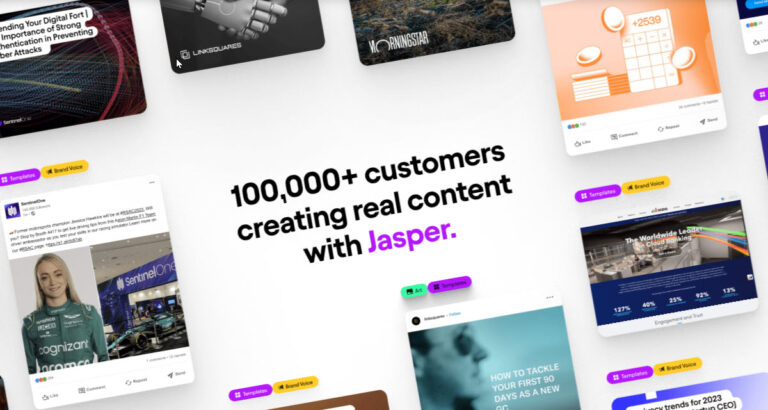AI Sales Copy Creation: A 10-Step Story

Sales copy can be a very intimidating form of content creation, even for online entrepreneurs whose entire goal is to sell products and services to others. And that’s where AI sales copy can help, if you know what you’re doing.
Instead of being able to write casual, informative content, online entrepreneurs feel pressure to be more hard-hitting or pushy with the wording, which makes them feel almost spammy.
You don’t have to feel any guilt in creating copy that converts. But it may not be a style of writing that you’re used to.
If that’s the case, AI sales copy can help you get the hang of it and even produce a sales letter that turns your visitors into buyers at a higher conversion rate than you previously enjoyed.
If you were to hire someone to create professional sales copy for you, it would cost much more than what a ghostwriter charges for a blog post.
And as long as you understand how to feed your AI tool with the correct information – and redirect it when necessary, you can cut costs and have a sales letter that performs and delivers a good result.
Whether you want to use an AI tool to write your copy from scratch or have it improve your sales page, you’re going to love the lessons below that teach you how to use these tools to write:
- headlines,
- storyline,
- bullet points,
- a call to action,
- postscripts,
- add data,
- use a USP,
- create scarcity and more!
Step 1: Turn Into an AI Sales Copy Expert
Artificial intelligence tools are language-processing databases programmed into how humans think, speak, and write based on information already online.
And if you went and looked at all of the human-created content, you would see many different styles and tones.
If you don’t prompt your AI tool, it will write in an elementary manner.
So you want to feed it the preliminary information that you need it to grasp before it begins crafting the copy for your product.
The first thing you want to do is tell your AI tool that you want it to write from the perspective of a top copywriter.
Start by saying: “Act as a top copywriter for online info products.”
Then, you’ll instruct it to learn who your target audience is and what tone you want it to use when writing for them.
Add this to the prompt:
“I am selling an info product called A Newbie’s Step-By-Step Guide to Internet Marketing Success. Who do you think my audience is for this eBook and video course? Name the demographics.”
The result AI came back with was too generic – such as any age, any gender, but mostly young adults and middle-aged individuals. We want more specific demographics for it to consider.
So we’ll redirect it like this:
“I want you to be more specific. For example, one audience might be senior citizens on a limited income. Give me a list of potential buyer types for my product.”
That did the trick! Now AI knows that it should be considering more specific groups such as:
- Stay-at-home parents
- College students or graduates
- Retirees who need or want a side hustle
- Individuals with health issues or disabilities who need to work from home
- Small business owners who wish to expand their presence online
- Freelance workers who need to reach clients and earn more
- People who want to travel while working
- People who are sick of their traditional job and want to become entrepreneurs
- Anyone who needs to make more money
Now that AI knows your target audience prompt it to understand the tone and style you want it to use when helping you with your copy.
“Soon, I’ll be having you help me create a sales letter for my info product, and I want you to keep these types of people in mind when writing it. I want the tone to be empathetic with their struggles yet motivational so that they can achieve their goals. Do you understand AIDA?”
We want to end with a question because AI sometimes tries to respond with something if you give it a statement, so it might try to whip up some sales copy before we are ready.
We want AI to focus our sales copy on the AIDA strategy, which stands for Attention, Interest, Desire, and Action.
AI responds that it does understand this and explains what it is correctly.
We will prompt AI to understand how we want our sales copy to unfold.
“In the sales copy I’m going to have you write soon, I want you to start letting them know you understand their problems, and build up to introduce the solution (my eBook) and motivate them with a strong call to action. For now, I want to make sure you understand my goal. What do you need me to provide to help you create the sales copy?”
One thing that many people never think to do is ask your AI tool what it needs from you to complete the task. This question is a vital prompt that helps the tool work better.
The answer that AI provided to this question was:
To create a compelling sales copy, I would need a clear understanding of the product features and benefits, the target audience, their pain points and desires, and the product’s unique selling proposition. Additionally, it would be helpful to know any specific objections or questions potential customers may have and any social proof or testimonials available to support the product’s value. Finally, understanding the desired outcome or action from the reader would also be essential to ensure a solid and persuasive call to action.
Now you know what you need to feed AI to get it to create the perfect sales copy for you.
When you review everything your tool delivers, check to see if it has enough hype or is too plain because you can always tell your AI to excite your headlines or content.
Step 2: Feed Your AI Tool the Basics of Your Info Product
What’s funny is we will make AI create some of the things it needs from us.
But it needs our help to make it think how we want it to. We will have to develop some of the items on our own.

For example, we might want to set our price point or discount codes and tell it specifically if there’s any scarcity, such as limited copies or launch pricing.
If you have used AI to create your info product, and it is one of the tools that remember previous conversations, it will have an easier time understanding the product features and benefits.
But if it didn’t do that for you, or if you changed it a lot from what it initially created, you will need to enter that information yourself so that your AI tool can then work from those parameters to craft the copy you need – so let’s work from its list:
Product features:
In our case, we are going to work off of the premise that we have the following info product: A Newbie’s Step-By-Step Guide to Internet Marketing Success, which is a 29+ page, 11,314-word report that includes the following chapters:
- Finding a Profitable Niche
- Business Models for Online Entrepreneurs
- Building Your Online Presence
- Content Creation and Marketing
- Free and Paid Traffic Options
- Lead Generation and Email Marketing
- Monetizing Your Online Business
- Scaling Your Online Business
- Time Management and Motivation
- Networking for Newbie Marketers
It also includes the following bonus items:
- Video modules of the lessons
- A cheatsheet of the main steps you’ll take to start your own business online
- A checklist called 10 Working Parts for an Online Business
- SEO Checklist
Product benefits:
Product benefits are something that the AI tool can create for us. But we must give it the outline first and then prompt the question. We will tell the AI:
“The product features are as follows: (insert list of the product features from above). Based on that, what product benefits do you think the buyers will have?”
The AI tool did an excellent job of coming up with the benefits:
• Comprehensive guidance: The eBook covers various aspects of Internet marketing and provides step-by-step advice on how to start and run an online business successfully.
• Time-saving: The product helps buyers save time by providing all the necessary information and tools to succeed in one place.
• Cost-effective: The eBook helps buyers optimize their marketing efforts and save money in the long run by providing guidance on free and paid traffic options.
• Increased revenue: The eBook’s focus on monetizing and scaling an online business can increase buyers’ revenue and financial stability.
• Practical tips: The bonus video modules, cheat sheet, checklist, and SEO checklist provide helpful information that they can use to start and scale an online business.
When you prompt the AI tool with:
“What else do you need from me to come up with a comprehensive list of benefits for this product?”
It tells you that it still needs some other items, such as your audience’s pain points, the demographics you are targeting, etc.
So, you may want to prompt it again after you have come up with all of that additional information to see if it has any other benefits it can include in the sales copy.
The target audience:
We will remind AI that we like the list of audience descriptions it came up with earlier.
If you tell the AI that you want the target audience to be the list it created earlier, with stay-at-home parents, students, retirees, etc., it will come back with a more specific list of benefits that include things like:
• Provides step-by-step guidance for beginners to start an online business from scratch
- Offers insight into how to identify profitable niches and business models
- Helps users build a professional online presence, including website creation and content marketing strategies
- Provides information on free and paid traffic options to allow users to generate more leads and grow their business
- Offers tips on the monetization of an online business, including increasing profits and earning passive income
- Provides insight into scaling an online business, including automation and delegation
- Offers information on time management and motivation to help users achieve work-life balance and stay focused on goals
- Guides networking for newbie marketers to help them build relationships and connections
Audience pain points in AI sales copy:
Pain points are another area where your AI tool can come up with the information, and you can oversee the process to ensure it includes everything from a human perspective.
So let’s prompt AI like this:
“Based on the list of target audience possibilities you created before, what pain points might they be experiencing? For example, seniors might be on a limited income or simply bored and want to have a career. Create a list of pain points for each demographic example.”
Again, AI does an excellent job of nailing down the struggles of each category. It tells you:
Stay-at-home parents
Struggling to balance work and family responsibilities, feeling isolated, wanting to contribute to household income
College students or graduates
Student loan debt, difficulty finding a job in their field, lack of experience, feeling unsure about their career path
Retirees who need or want a side hustle
Limited income, boredom, desire to stay active and engaged
Individuals with health issues or disabilities who need to work from home
Difficulty finding traditional employment that accommodates their needs, medical expenses, isolation
Small business owners who want to expand their presence online
Difficulty reaching a wider audience, feeling overwhelmed with marketing tasks, lack of tech skills
Freelance workers who need to reach clients and earn more
Difficulty finding clients, competition with other freelancers, feeling undervalued
People who want to travel while working
Limited job opportunities that allow for remote work, difficulty affording travel expenses
People who are sick of their traditional job and want to become entrepreneurs
Feel unfulfilled or unhappy in their current position, desire more control over their career and income, fear-of-failure or uncertainty
Anyone who needs to earn more money
Financial stress, feeling trapped in their current job or situation, desire for more financial freedom and stability
Read those struggles and check if anything needs to be deleted or expanded upon. You need to do that now and notify AI about the changes.
Their desires:
Desires go hand in hand with pain points. Often, the goal is to eliminate the struggle. But we want to prompt AI to think in the most positive measures rather than just removing any obstacle.
So we will prompt our tool like this:
“Without focusing on eliminating pain points or struggles, name some common desires and goals people have for learning how to start an online business. Make them all positive.”
It will give you a perfect list for your purposes, but always read through and eliminate or add to anything you feel needs to change, and again, notify AI of your changes:
- Financial freedom and independence
- Flexibility in work schedule
- Ability to work from anywhere in the world
- Being your own boss and having control over your career
- Pursuing a passion and turning it into a profitable business
- Creating a better future for yourself and your family
- The potential for unlimited income and growth
- Helping others through your business or product
- Diversifying your income streams and having multiple revenue sources
- Achieving personal and professional fulfillment through your work
Unique selling proposition in your AI sales copy:
AI can develop a unique selling proposition (USP) for you. Prompt it like this:
“I need a good USP for this info product. Can you write three strong ones for me to consider?”
You’ll then pick which one you like best – and tweak it if you want to before telling AI which one to remember based on what it responded with:
• Unlock the Secrets of Online Success: Learn the step-by-step process for building and growing your online business, from finding the perfect niche to scaling your operation and everything in between.
• Your Blueprint for Internet Marketing Mastery: This comprehensive guide provides all the tools you need to start and grow a successful online business, with video modules, cheat sheets, checklists, and more.
• Fast-Track Your Way to Online Success: Cut through the confusion and overwhelm of starting an online business with this easy-to-follow guide, designed for newbies and packed with practical tips and advice.
I like the third one, but it’s missing the step-by-step wording. So, let’s change it (or you can prompt AI to do this for you) and make it read: “Fast-Track Your Way to Online Success: Cut through the confusion and overwhelm of starting an online business with this easy-to-follow, step-by-step guide designed for newbies and packed with practical tips and advice.”
Any specific objections or questions that potential customers may have:
We are going to tell AI what we’ve chosen for our USP and prompt it to give us the objections and questions like this:
“The new USP will be: Fast-Track Your Way to Online Success: Cut through the confusion and overwhelm of starting an online business with this easy-to-follow, step-by-step guide designed for newbies and packed with practical tips and advice. What common questions or objections do you think the potential buyers might have for this product?”
It comes up with questions about whether the product is suitable for those without prior experience, if it will provide actionable advice, how it’s different from other products, if it’s too technical for newbies and more.
The desired outcome or action from the reader:
In this one, we’re going to prompt AI not only to understand that we want visitors to click on the buy button and buy the product but that its pricing is at a launch price point 50% less than what it will be in one week.
This pricing touches on the discount and scarcity simultaneously.
So let’s prompt this last thing before we begin having it create the copy:
“The goal of the sales copy is to have the visitor click the buy button and purchase the product before the discount ends. The price for one week only is $27, but it will go up to $47 in one week. Do you have everything you need to continue writing the sales copy now?”
It replies: “Yes, I have enough information to continue writing the sales copy.” So we are ready to go!
You must take these preliminary steps to feed AI everything it needs so that it can do the best job possible for you.
There are different ways you can go about having it create sales copy. You can ask it to write a sales letter, but it will be limited in the sales copy content it will send back to you.
You may want to take it piece by piece, such as starting by having it create headlines that you can use in your copy, including a main headline at the top of the page, as well as several subheadings.
Then, you can move on to the storyline, the solution, bullet points, etc.
This process is usually a better way to get what you need from your AI tool regarding sales letters, as long as you are willing to put it together.
If you prompt AI to write your sales letter without going piece by piece, it comes back with a “Dear Aspiring Entrepreneur” letter totaling 279 words.
Suppose you have been in Internet marketing for any length of time. In that case, you’ll know that sales copy usually scrolls several pages deep, so this is not enough information to convince prospective buyers to click the buy button.
Step 3: Including Headlines and Subheadings In Your AI Sales Page
Usually, when you look at a sales letter for an info product, you have a main headline and several sub-headlines strategically placed throughout the copy.
These multiple sections help break up the text and introduce new areas of the page.
There were no headlines in the original sales letter that AI created.
So it would be best if you prompted AI like this after it writes your short copy:
“That’s okay, but let’s make it much longer. First, I want you to develop a list of possible headlines for this sales letter. Some might focus on what they can achieve. Some might focus on problems it’ll fix. You might have some that ask questions, some that shock them or give them a push in the right direction. Give me a list of as many strong headlines as you can that I can use throughout the sales letter.”
It will deliver a list of 10 headlines in the styles you’ve given it – in this instance, we chose to have it use questions, goals, struggles, and motivation.
Choose one for your main headline – the first one they’ll see on the page.
We’re going with: Discover the Step-by-Step Guide to Internet Marketing Success That Will Help You Build a Profitable Online Business – Even if You Have No Experience!
Go through the list to pick out any additional headlines you want to use as your copy unfolds.
Feel free to mix and match and tweak them. We will select the following headlines to use in other places, too:
- For our subheading before the intro and storyline with empathy – Are You Tired of Wasting Time and Money on Strategies That Don’t Work? This Guide Will Show You How to Succeed!
- To use in our section to help them imagine the possibilities – Unlock the Secrets Competitors Don’t Want You to Know So You Can Build a Business Like a Pro – Even If You’re a Complete Newbie!
- When we introduce the fact that there’s a solution to the problem (our product) – Are You Ready to Take Your Online Business to the Next Level? This Comprehensive Guide Will Help You Get There!
- Before the bullet point benefits – Struggling to Get Your Online Business Off the Ground? This Foolproof Guide Will Teach You Everything You Need to Know!
- Just before our Call to Action (CTA) – Are You Ready to Start Your Online Business Today? Get the Ultimate Guide to Internet Marketing Success!
You can start a file with these organized in this logical order.
People write sales letters differently, but it’s good to have your headlines to break up the sections.
Start with an introduction and storyline that evokes empathy and shows you understand their needs.
Then touch on the possibilities they can imagine, the solution, and the specifics of your product, before delivering a call to action.
Step 4: Let Your AI Sales Copy Deliver a Gut Punch of Emotions Addressing Your Audience Pain Points
Addressing pain points is the basic setup of most sales letters. We want to prompt AI to write an introduction that evokes emotion.
Many of the people who will be buying this product feel emotional.

They might be worrying about finances, feeling lonely, stressing over having to stick their kids in daycare and go to a job that causes them anxiety or frustration, and more.
While AI might know the essential “flexibility in work schedule” line, it can’t automatically comprehend the emotional component of walking away and seeing your child cry because you must work to support your family.
You may have to prompt AI several times to get what you need. For example, we told AI:
“I want you to write a 400-word introduction for my sales letter that JUST lets the reader know I understand their pain and struggles. I want you to be very emotional and paint a picture. For example, the parent wanting to work from home might feel stressed walking away from a crying child they had to put in daycare to go to a job they hate to make ends meet. Don’t talk about solutions. Give empathy.”
But what resulted was two paragraphs of empathy, followed by a sales spiel trying to pitch the product. That’s too soon. So we need to redirect AI by saying something like,
“No. I want the entire 400 words to be about their struggle. Don’t tell them there’s a solution or say anything about the guide. Go through examples of the prior demographics and talk about the emotional struggle, the financial struggle, etc. for them.”
The results were a bit better, but what it did this time was it took each of the demographics, such as stay-at-home parents, students, retirees, and more, and went through a list where each one got its own paragraph.
We need one more prompt to get what we need. We will tell AI the following:
“Can you write it more like an article without listing each demographic in order? For example, discuss the financial struggle and then bring in some demographics, job security, emotional struggle, etc.”
That did the job better! Now, it gives us many emotional struggles people deal with, such as struggling to make ends meet, being unable to spend enough time with family, and more.
We want it to hit on everyday struggles this demographic has experienced in this industry so that we can set ourselves apart.
So let’s prompt AI like this:
“Write a few paragraphs about some of the biggest struggles people have in learning how to start an online business.”
Now you’ll want to go in and tweak it slightly if it didn’t return what you wanted it to.
In our case, AI did a great job of hitting on all the crucial struggles people go through, such as being overwhelmed with the amount of information out there, but it just needed to be polished up a bit so it didn’t read more like a list.
Sometimes, you might have phrases you have put together in a swipe file from sales copy you’ve seen and want to use those in your copy.
You can prompt the AI by saying:
“Can you write sentences about their struggles, including phrases like “are you experiencing,” and “the sad fact”?”
These are sometimes good to weave into your copy.
For example, AI came up with questions like: Are you experiencing financial strain and feeling like you can’t get ahead no matter how hard you work?
It added, “The sad fact is, many people find themselves in this situation, struggling to make ends meet and not seeing any way out.”
This type of wording helps your reader see themselves in the copy, which is precisely what you want to happen before you present the solution to them.
If they feel as if you “get them,” it goes a long way in helping them take down their barriers and feel comfortable buying from you.
Here is also an excellent place to insert any of your storylines, and if you have a particular struggle you want to write about, you can add that to the introduction.
Or, you can give AI the details and let it write them for you.
Step 5: Use AI to Help Readers Imagine a Solution
Before you introduce the solution, you want to have your reader imagine how life would change for the better if they could achieve the goals they want.
So we will prompt AI with this:
“I want you to write some paragraphs based on the struggles above that help the reader imagine how much different and better life could be if they could build a successful business online. What would change? Paint a picture for them that helps them see the possibilities. Use examples.”
The results that it provided were terrific as is. But you can add your own details or human elements and personal storylines that work in this section to help them connect with you.
It gave specific examples about never missing a child’s school event, no longer neglecting your own mental and physical well-being, being able to travel anywhere in the world while working, etc.
Sometimes, you may want more imagination used.
So AI says this: “No more long commutes, stressful bosses, or feeling undervalued.”
Let’s prompt it to paint a picture by saying this:
“I like the part where you wrote “No more long commutes, stressful bosses, or feeling undervalued.” Can you describe what life would be like working for themselves from home? Be detailed and cozy about it.”
The AI tool delivered a fantastic result, describing everything in detail about sipping your coffee and taking breaks when you want throughout the day. Lacking the human element, you can tweak it where needed.
For example, the AI tool talks about how you get to decide how much you earn and that there is no more settling for a fixed salary or waiting for an annual raise.
If you’ve ever had a corporate, nine-to-five job, you know there is a humiliating element in begging your boss for a raise so that you can add that into the copy.
Step 6: AI Can Introduce the Product That’s Going to Solve Their Problems
Your product introduction will be a relatively short section of your sales letter. You want AI to pull from the information you initially fed about your product and write a piece about how your guide, introduced in this section, will help them solve their problems.
We will prompt AI like this:
“Based on the details of the product as well as the audience’s struggles, I want you to write some paragraphs introducing my info product and discussing how it can serve as a solution to their problems. Be heartfelt about it and help them overcome skepticism they may have.”
The AI tool did reasonably well writing the copy, but I wasn’t impressed with the first and third paragraphs. They have rehashed information from earlier in the copy. So I instructed the AI to cut those two paragraphs and redo it, adding a bit about any skepticism they may feel.
That resulted in a much better version of this product introduction section. There is still minor tweaking to do so that it fits your style and tone. You can make those tweets yourself or instruct AI to do it, but sometimes it’s faster to do it yourself.
Step 7: Develop Strong Bullet Point Benefits Using AI as Your Guide
Now, we need our AI tool to develop some bullet point benefits. Covering benefits is another place where you may need to feed AI information about each particular chapter or module of your info product.
Remember, AI only knows the chapter titles in this session, not necessarily all of what goes into the product. You don’t want to allow it to work from the chapter titles because it may put something in a bullet point that isn’t necessarily in your course.
You also want to give AI specific power words that you want to use that you have seen used in other sales copy before if you have any particular ones that you like. Otherwise, the bullet points may be too plain.
You can also use action verbs that help the copy and bullet points have more of a punch. Prompt AI like this:
“I’m going to give you chapter 1 of my info product. Please create a list of actionable bullet points for my sales copy based on the chapter about what they get when they buy it. Here’s chapter 1: (and insert the chapter).”
The AI tool returned with some pretty plain bullet points, such as, “You’ll learn how to identify a profitable niche that aligns with your interests and skills.” That’s extremely boring!

Prompt AI again by saying: “Excite them up to be more salesy.”
Then it came back with this revamp: “Discover How to Find a Niche That Aligns with Your Passions and Skills and Make Money Doing What You Love!”
Much better. You can even tell it to shorten it or prompt AI to use phrases like Shocking, Step-by-Step, Uncover, Unleash, etc. Continue doing this for the rest of your product, gathering about 1-2 from each chapter or module.
If you don’t want to feed it your entire chapter or create it in a video, you can tell it the benefits of that chapter or module and have it come up with exciting bullet points.
Keep prompting AI to get what you want, like this: “I’m going to paste chapter 2 in here, and I want you to use powerful action verbs commonly found in bullet points on sales letters to create a list of bullet points for what the reader will find in this chapter: (insert chapter).”
It did a great job with this one, but many of the bullet points talked about specific business models, and we want to keep the bullet point generic for this chapter, so we’ll redirect AI like this: “I like the second to last one. Can you create ten bullet points using the word Explore in the beginning and be generic about picking the business model?”
It came up with some results that we could mix and match slightly to get this: Explore the Benefits of Different Online Business Models and Learn How to Find the One That Fits Your Unique Strengths and Interests!
Step 8: Let Your AI Sales Copy Seal the Deal with a Call to Action
Before you have AI blurt out a list of call-to-action phrases, you want to have some copy that sums up what you want the reader to feel when they reach this part of your sales letter.
You can prompt AI to write that for you like this: “I want a summary before the call-to-action statement – something that sums up the offer, why they shouldn’t delay another minute, what they’ll be missing out on if they pass it up, etc. Can you write a few paragraphs for that?”
The AI tool wrote an excellent summary for us. It also included a weak call-to-action sentence. So, then we tell AI: “I need a strong call to action statement for my info product. Give me 25 short call-to-action phrases for this sales letter.”
You want choices, not sentences or paragraphs. The call-to-action is the short text that goes above your buy button. You can have things like: “Click here to unlock your potential today” – or “Don’t wait another minute to change your life!”
If anything turns out bland, make it redo it with a more hyped-up or sales approach. If they’re too long, tell it to shorten them. If you want specific words used, feed them to the AI – you are in complete control.
Step 9: Any social proof or testimonials available to support the product’s value
We’re not using social proof or testimonials, but if you have some, you can add those to the AI discussion so that it knows what to include when crafting your sales copy.
Step 10: If you want to, add a section for the bonuses
In this example, it would include:
• Video summaries of each chapter – turned into slideshow modules in case you prefer to watch rather than read the information
• A Cheatsheet of the main steps you’ll take to start your own business online
• A Checklist called 10 Working Parts for an Online Business
• And an SEO Checklist
You can prompt AI to write a paragraph and headline to include in your sales copy.

Step 11: Don’t Forget to Have AI Craft Powerful Content Below the Buy Button
Some of the most powerful content on a sales letter is after you sign your name and include the buy button. Many shoppers scroll down to the postscripts to see how you have summed up your offer.
AI is excellent at creating these. You can prompt it with specifics if you know what you want to do in them. For example, you might say,
“Can you give me a postscript message summarizing how this product will benefit them in one to two sentences?”
If it comes up with boring results, such as gaining the knowledge and skills you need, you can tell it to make the benefits more attractive. Then, it comes back with wording like explode your income and finally gain the freedom and lifestyle you’ve been dreaming of.
Much better! You can also do a second postscript, known as the PPS, and ask it to write one about the scarcity involved in the offer, which is a 50% off discount and just one week to buy the product.
It comes back with a perfect postscript for you to use, but if you want to tweak it in any way, you can do that.
Some people also like to include more sections in their sales copy, but this is a basic sales letter format that can serve you well, and in between the content that you had AI create, you can add testimonials, excerpts or demos, etc.
Ultimately, you want to feed AI your finished copy and ask it to improve based on the AIDA model or whatever sales copy model you’d like it to follow. You can also have it check for errors or help the finished copy polish up however it sees fit.
When we ran our finished copy through AI to ask, it suggested testimonials and more urgency to the call to action. So instead of saying, “Click here to unlock your potential today,” it tweaked its result to say: “Click Now to Take Advantage of This Limited Time Offer and Start Building Your Dream Business!”
So, we’ll take its advice.
But make sure you don’t just use whatever it replies! You must read back through and approve any changes to ensure they are better than what you already have, make sense, and are accurate for your readers.






